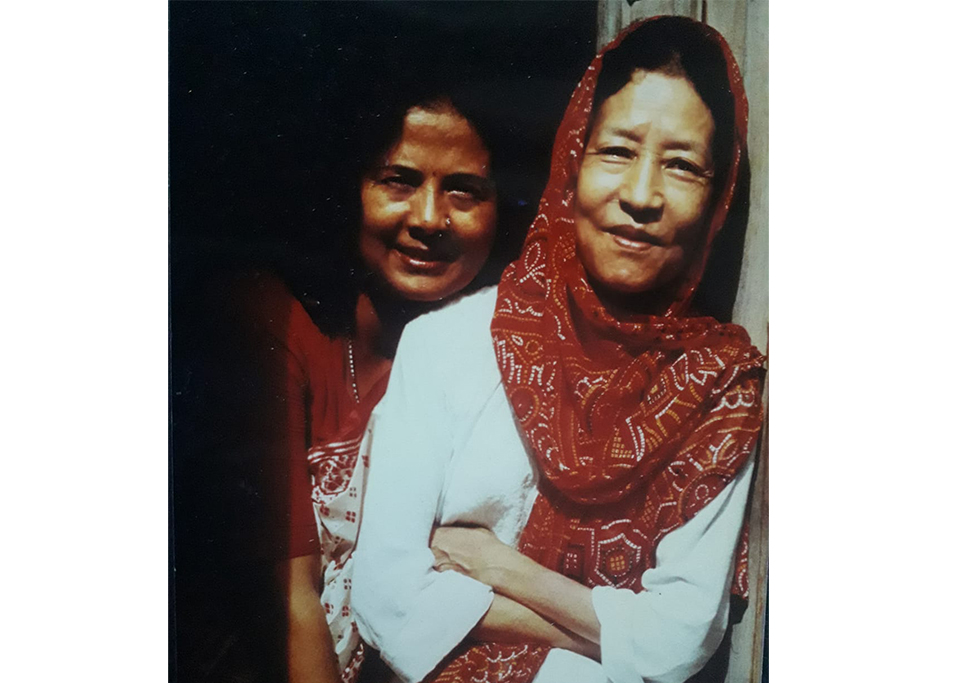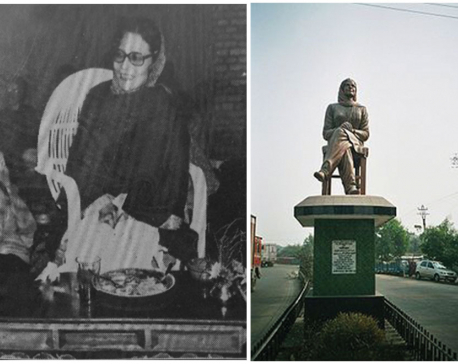
OR
Colors of "Shirishko Phool" : Parijat, BP Koirala and Banira Giri
Published On: May 9, 2020 12:48 PM NPT By: Dr Mahesh K Maskey


Dr Mahesh K Maskey
The author, former Ambassador of Nepal to China, is also a former Vice President of International Physicians for Prevention of Nuclear Warnews@myrepublica.com
For Parijat, literature became the means to nurture a sense of purpose in individuals as a conscious subject of history in building a human society free of class conflict, hence war, a society that strives for social harmony and transits from the realm of necessity to the realm of freedom.
Baishakh comes to us adorned with the splendors of Spring. Corona scare has locked us within our houses and most of our daily routines and social life have come to a screeching halt. But nature has not stopped her cycles of seasons, birds have not stopped chirping, and flowers are blooming in all their colors as if nothing has happened.
Once again Kathmandu's ambiance is filled with the beauty of Jacaranda blossoms: the blue mimosa flowers or the shirishko phool. Once again the month of Baishakh and shirish flowers bring memories of Parijat to us. Parijat lives on in her immortal literary creations, in the legend of a life lived through daunting personal and social struggles, in the symbol of her undefeatable will. Her presence is felt all year round, but this month is special. She was born in this month, and she also died in this month. And shirishko phool connects us to her persona, for diverse reasons.
For a long time, I looked at the jacaranda blossoms through the lens of Parijat's celebrated novel Shirishko Phool...a flower that wilts and falls in the first kiss of a bumblebee. A philosophical expression of the meaninglessness of birth and death, and for that matter, life itself. The sight of jacaranda blossoms came to me as a silent whisper of existential absurdity, or at best, a song of a melancholic existence. My first correspondences with Parijat during the beginning of the 80s, started with my reflections on this novel. By that time, she was already distancing herself from its philosophical-ideological underpinnings and rejecting its prescription for life. True, she never underestimated its artistic merit, nor did she belittle her honesty and sincerity in giving life to its substance. But her leftward journey of two decades since then was so dramatic and inspiring that in one fateful day she declared "let ‘Shirishko Phool’ be burned to ashes".
Like a butterfly flapping its wing to explore limits of the sky after it morphs from a caterpillar, Parijat’s newfound identity would neither be nostalgic nor would defend her past associated with the “Shirishko Phool” era. She would invest her creative energy in the service of that class which she found most humane and historically destined to bring radical changes both in the political system and human society. She would look at everything from this standpoint including her past—Shirishko Phool included. She would struggle to present her nuanced view about the book in a very clear and straightforward manner, disowning its underlying philosophical essence, but holding to the sincerity of her own personal feelings that helped create it, and to its artistic form.
But then, as we were to witness, the book did not perish in spite of her harsh verdict. It still remains a bestseller and a hard to resist attraction for many newcomers and old connoisseurs. It could be that the same impulse which urged the writer to write Shirishko Phool runs deep in these readers too. Or perhaps some readers see things beyond what the writer has imagined, or they see the same thing differently than the writer. Parijat's call to destroy her own work only appears to have whetted the reader's curiosity, increasing its readership. Once a work of creation passes from the writer or artist to its reader or viewers, it perhaps no longer remains the work of the artist only. It becomes a part of the reader too.
It would be hard even for Parijat to understand such continued attraction to this work, but it would not be new for her. Nor such attraction could buzz her from her stand. In a recent article, Parijat’s sister Sukanya mentions such range of personalities from Dhrub Chandra Gautam to Nirmal Lama whose favorite was Shirishko Phool. But I think their likes or dislikes would hardly elate or bother Parijat. She had made her statement more than once, and was consistently clear about why she rejected it. She seemed to be more concerned about making her stance clear for the posterity. In simple words, she maintained that the substance of Shirishko Phool is anti-life and anti-people, while its artistic form was captivating. She faced the critiques, both right and left, from this standpoint.
And she said it without mincing words. The evolution of her thoughts, from just after the publication of Shirishko Phool to her shocking statement to burn it, is in the print for anybody to see. Parijat has traversed a long journey after the publication of this book. This journey itself is a testimony of her changed view of life which has found expression in her later works. Sukanya has divided Parijat’s life mainly into two parts, the first half engulfed by hopelessness, and the second half teeming with life. Attempts to confine Parijat to Shirishko Phool only may succeed in understanding her in part. That part which she herself accepted as one phase of her life but which she consciously struggled to come out of, and then left behind.
The first half was a time when she was struggling with her death wish, born out of a life so full of pains, disease, insecurity and tragedies. Not only Shirishko Phool, but her celebrated poems like “lahurelaai rogi premikako patra”, “marna mana lagchha mayalu” and “Mrityuko Angaloma” paint the same picture. In the second half, as she embraces life, most of her pains and struggles become harbinger of hope. She wrote a death defying poem “Mrityu” in that spirit. Declaring death neither as an absurdity or an end to life, she uses it as metaphor for transformation. Loss of one physical existence is transformation into new existence of many. If a life is devoted to a cause bigger than the life itself, then such transformation fuels the motion of a movement, granting it the power to create and change. She used her pen as a weapon in class struggle, firmly standing with the most revolutionary class and actively participating in the historical task of social and economic transformation.
Many who adored Parijat saw this latter development as Parijat’s blundering into narrow lanes of Politics. Among them was Banira Giri, to whom I am immensely grateful for a different reason. An acclaimed poet-writer who like Parijat came from Kurseong, Darjeeling and settled in Kathmandu. She also differed with Parijat about her verdict on this book. I have read only a few of Banira’s works, but I have read and re-read many a times her memoir "shirishko phoolharu laai sodhnu", written after Parijat' s demise. In that memoir, complaining to Sukanya for not letting her speak to Parijat in her deathbed in Bir Hospital, she says Parijat continues to speak to her, nevertheless: “Every year Parijat speaks to me through jacaranda blossoms.” “Don’t you believe me Sukan? Ask the blue or onion-purple jacaranda blossoms! ”.
Banira always had difficulty in figuring out the color of these flowers, but her memoir gave me a different view of jacaranda blossoms. I started seeing Parijat in these flowers, not Sakambari. The gloomy whispers of existential absurdity disappeared gradually. Since then as I pass by these trees laden with flowers, I too feel Parijat speaking to me. I don’t know which Parijat speaks to Banira, the earlier or the later one? But I owe this changed impression to her. From there I take my own flight. Rather than seeing its flower wilting and falling in a kiss of a bumblebee, I could see flowers fall but new ones take their place. And that is the secret of the existence of Jacaranda blossoms. The fall and the birth of flowers are not meaningless, it is rather essential to maintain that existence for the whole season. Taking it further in the context of socio-political struggle, I remember the immortal words of Parijat commemorating the fallen martyrs in another celebrated novel of her Anido Pahad Sangai: “just as new flowers spring in the place where other flowers have fallen, martyrs also spring in the place where martyrs are fallen . Like flowers, martyr’s blood also have a special scent that permeates in the air….building of new society is not a mirage… it is a reality which is palpable in (wo)men’s hand”.
I find Banira’s memoir an outstanding piece of literary creation, written with deep love and respect for Parijat, and at the same time drawing her differences with a rare display of honesty. She was not happy with Parijat's involvement with politics, which she thought had suffocated and constrained the free spaces of Parijat's creative sky. She also expresses how she felt hurt about some American anthropologist wanting to meet her but later allegedly discouraged to do so by the said anthropologist's closeness to Parijat. Banira remembers this and expresses bluntly in the context of helping Michael Hutt to meet with Parijat. The implication being closeness to Parijat might, in some way, have influenced the anthropologist's decision about not meeting with Banira. We don’t know whether her impression was true or not but Banira has not hesitated to express it in her memoir.
Her recall of their conversation about Bisheswar Prasad Koirala’s Tin Ghumti is an illustration of same frankness. Highly impressed after reading this piece she runs to Parijat bubbling with emotions: ‘Did you read Tin Ghumti’ ? What a wonderful work!”
“No I did not, and will not”
Banira felt like falling from the roof. Angrily she said:
“Ok then, I will also not read your novels.”
“As you please” was Parijat’s answer.
This was Parijat. She worked closely with Nirmal Lama politically and related to him through Sukanya. Even though a communist leader, one of Nirmal Lama’s favorite political personality was BP Koirala. However, what Nirmal Lama thought of BP hardly mattered to Parijat. Parijat would not even read BP’s novels for reasons only she knows.
BP Koirala, who combined a persona of both an exceptional political and literary figure, is on record in sympathizing with the lead character Suyogbir of Shirishko Phool. In his “Thoughts on Literature” he finds in Suyogbir a person who is full of sadness and hurt because war has made him do things injurious to others as well as to himself. But he is not indifferent to life. He feels that his right to happiness has been robbed from him because his conscience is wounded by the war. Therefore for BP, he is somebody who deserves our compassion rather than scorn. Not only Suyogbir, BP Koirala finds this novel entirely opposite philosophy of emptiness, shunyavad or existential nihilism. He underlines his impression about Sirishko Phool: “here is the description of unbound affection towards life”.
In contrast, later Parijat held that Sirishko Phool is against fundamental life-values. Suyogbir stood for everything Parijat would want to reject. He was personification of the meaninglessness, the emotional void and the absurd that formed the core of Shirishko Phool. True, he was a product of his circumstances, utterly frustrated, defeated and dehumanized in war, and she also sympathized with him for his suffferings. But now with her changed views, she held that the task of literature is not to justify such dehumanization in the pretext of war, nor to present such absurd state of mind as philosophy of life. The task of literature is to create conditions to do away with wars and enable individual to show heroism at the face of most demanding situations. In other words, literature should help abolish the conditions for emergence of characters like Suyogbir altogether, rather than rationalizing such existence.
It is important to note that in a deeper personal level she identified her past with Suyogbir and not with Sakambari. She says in one of her interviews: “the life I have lived is that of Suyogbir!”. It should also be noted that her own life experience that urged her to write this novel had blended with the dominant worldview of that time to which many of the world renowned intellectuals had gravitated. Later, when she believed human beings are capable of rising above existential angst, and prevent and change the circumstances that govern their life, she started having a different look at Suyogbir as she began to have a different view of her own past. For Parijat, literature became the means to nurture a sense of purpose in individuals as a conscious subject of History in building a human society free of class conflict, hence war, a society that strives for social harmony and transits from the realm of necessity to realm of freedom.
Could this difference, in reading and understanding Suyogbir and Shirishko Phool between the writer Parijat and the reader BP, be the cause forParijat’s apathy towards BP’s other literary works? It may be a question students of literature may like to ask themselves. Be what it may, Banira Giri’s anger on Parijat’s refusal to read BP did not last long. In the same memoir she recalls traveling from Lahan to Janakpur in a bus where she saw Parijat’s newly published book Toribari Bata Ra Sapanaharu in a fellow traveler's hand. She could not resist, and borrowed the book for a cursory look, but finished reading it before reaching Janakpur!
I have heard Banira is suffering from memory loss and is bedridden at present. Her family and friends are taking care of her. I wish and hope that she will get better soon to enjoy the enchanting view of jacaranda blossoms, and want to let her know that her memoir has given us a glimpse of rare beauty, love and honesty that literature is capable of.
As I walk past the rows of jacaranda trees near Ratnapark, I hear the whispers of Parijat and Banira this time, softly telling me the story of their unique friendship, their agreements and disagreements. I look at the color of the blossoms gently swaying against the backdrop of cloudless sky, and wonder whether Banira’s difficulty to differentiate blue or onion-purple, was related to the color of the shirish flowers or to the color of Shirishko Phool.
You May Like This

Remembering Parijat
Baisakh brings memories of Parijat, the celebrated writer whose life was no less spectacular than her epic novels. She is... Read More...

Remembering Parijat (biopic)
KATHMANDU, April 18: Bishnu Kumari Waiba, popularly known as Parijat, was born in 1937 in the hill station of Darjeeling, India,... Read More...

Parijat, Pragitishil into semis
KATHMANDU, Nov 7: Parijat Youth Club and Pragitishil Youth Club have made it to the semifinals of the Third TAAN... Read More...










Just In
- NRB introduces cautiously flexible measures to address ongoing slowdown in various economic sectors
- Forced Covid-19 cremations: is it too late for redemption?
- NRB to provide collateral-free loans to foreign employment seekers
- NEB to publish Grade 12 results next week
- Body handover begins; Relatives remain dissatisfied with insurance, compensation amount
- NC defers its plan to join Koshi govt
- NRB to review microfinance loan interest rate
- 134 dead in floods and landslides since onset of monsoon this year








Leave A Comment